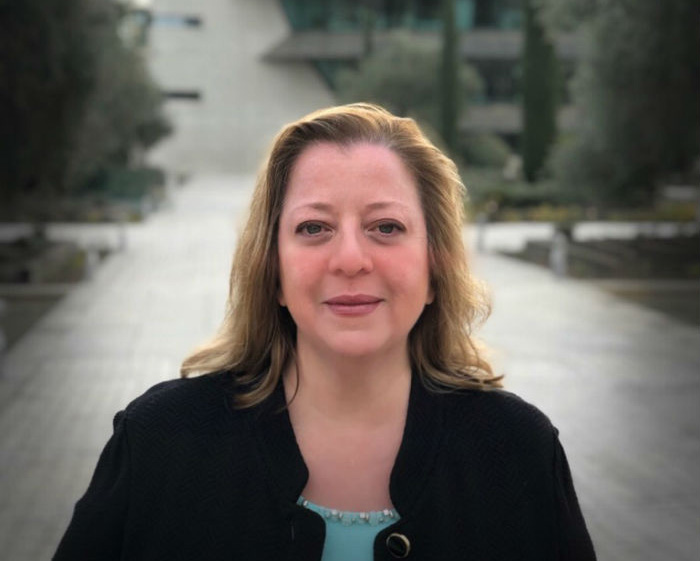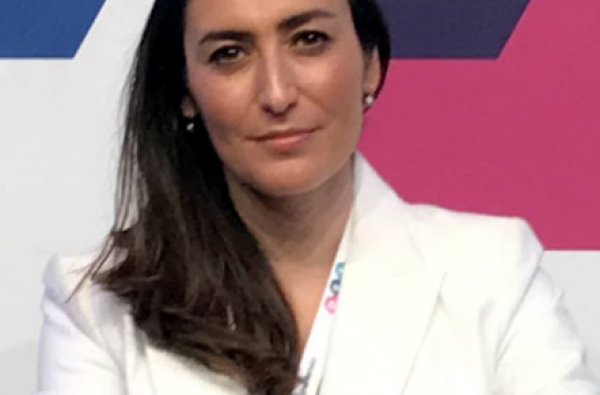The mission of Banco Santander's CTO, Julieta Ross, is for the finance giant to adapt with agility to a world and rules that are changing faster and faster. To this end, it is rapidly transforming itself internally, seeking allies in 'start-ups' and customers, and bets that the talent of the bank itself is a participant and adheres to the change.
"Working at something you love is no longer a job, it's a hobby," says Julieta Ross, global head of Technology Strategy at Banco Santander (CTO global). Her passion for technology came to her as a child, when her father gave her a computer and learned to program.
Since then, she has accumulated extensive experience in the world of technology: she studied electrical engineering, received a doctorate in computer engineering, participated in the development of Bluetooth technology and held the position of CTO in other banks in both Latin America and the United States.
Now, he is using that background to tackle the digital transformation of one of the world's largest banks. Among his greatest challenges is the need to build trust in digital environments, to adapt to change at the necessary speed and to make all workers feel part of this transformation.
Each year, MIT Technology Review publishes a list of the 10 technologies that may be about to change the world. Last year's list includes a technique for ensuring privacy in a blockchain. How is Banco Santander preparing to address the digital privacy challenge of its customers?
We have a solid information security structure and we analyse risks continuously. We actively manage the classification of data and assets, with different measures depending on the case and we also have training programs for users and employees to learn how to handle the data. It is an ongoing process to incorporate the latest technologies, to protect our applications and to authenticate our customers.
The conversation about data [and its privacy] gets interesting when we start talking about the public cloud, because in the last 10 or 20 years everything was stored internally in the private cloud. But now we are increasingly adopting solutions in public clouds [owned by other providers].
Will they increasingly opt for the public cloud?
What happens with the public cloud is that you extract data from the bank or from any industry and upload it there, where it is protected, encrypted. We own the private keys, but in order to use the data, you have to decrypt it. Then either the algorithm or the data must be unencrypted. But with some new technologies, like homomorphic encryption, the problem is reduced because we can execute algorithms and transactions with encrypted data.
The private cloud will always exist, because we will always have information that we don't want to get from the bank. But with time, its use will decrease because public cloud technologies are advancing at a great speed.
In addition to the cloud, Santander is also investing more and more in blockchain technology. They have launched a service that allows international transfers with blockchain and they have even used this technology to vote in a general shareholders' meeting. What is the reason for this strong impulse?
We believe that this is a transforming technology, which allows us to simplify operations, reduce operating costs and offer better services to our customers. We have invested through our [venture capital] fund InnoVentures in companies that use blockchain technology such as Ripple, which we use for One Pay FX [their blockchain-based transfer service], and also in companies such as WeTrade.
We are also interested in actively participating in quantum computing test scenarios. It has the potential to change the way the industry manages and manages security keys and certificates, which in turn affects technologies based on cryptography such as blockchain.
However, the chain of blocks makes it possible to decentralize management and eliminate intermediaries, which could pose a threat to the banking industry. Do you see this technology as an ally or do you think it could be a competition?
We do not see it as a potential competitor, but as a great opportunity to increase the efficiency of what we do. It is a technology, like many others, that at some point will change the business model, but it is a great opportunity for the industry to improve the customer experience, agility, and trust. We embrace it completely. And not only are we already using it, but we're doing more pilot tests to keep research going.
The new technologies are favoring the entry of companies into sectors that traditionally did not belong to, such as purely technological companies. How are you facing the arrival of fintech and how are you implementing these continuous technological advances?
On the computer engineering side, it is very interesting how the financial industry has evolved. Today, there are disruptive products, because we have fintech and start-ups that develop certain products and services with a better business model than that of a traditional bank. We work with them 100%.
But the interesting thing is that the bank's products and services are changing to include customer data and experience. Instead of the customer coming to take out a mortgage, we try to understand what is happening to him. Why is he taking out a mortgage? To buy a house. And what else do you need to do in that house? Then we can find an ecosystem that adds more value than just granting a mortgage. We are transforming ourselves into an open platform of financial services.
Almost 30 million clients of Banco Santander are now digital. Do you think that in the future there will still be physical offices or will all the formalities be carried out via the Internet?
The physical channel will continue to exist, but it will evolve, like everything else. Nowadays, almost half of our employees are in positions with regard to customers, contact centres, etcetera. They look you in the eye and create a bond, a relationship that gives confidence. Now we are going to a digital world that requires another more distributed trust model. We are starting to think about how to create algorithms that generate trust in a brand.
Do you think we will be able to establish human-like relationships with technology?
Totally, you just have to find the formula.

Customers are looking for simplicity and agility, but the technologies capable of providing these services are increasingly complex. How do you work internally to implement innovations at Banco Santander?
A very unique value of ours is that innovation is not based in an ivory tower, it is throughout the Group, in all our geographies. The framework of our technology is to be able to adopt local innovations very quickly. We have brilliant people on so many sides who are thinking about this all day.
In addition, innovation does not only come from our employees, it also comes from our customers, and sometimes they are spectacular. There are customers in sectors like agriculture who are adopting the internet of things and helping us learn, because suddenly we have to think about how we are going to adapt the payment model. They demand services that make us think and innovate. So not only do we have the strength of 200,000 employees, but 140 million customers.
Having a tech-savvy talent is a competitive advantage for any bank in the future. What profiles do you look for when capturing that talent?
The life cycle of technology used to be five to seven years, but now it's a year and a half. What we are doing right now, in a year and a half is going to be different. So it's not about having a group of people who are experts in a language to develop algorithms, it's about having people who are really passionate about technology, passionate about the industry and able to adapt to change.
In college I learned to program in C, in Pascal, in Fortran. The last time I did the math, I had learned 35 programming languages, and before I retire there are going to be many more. Today no one knows what we're going to need in two years, so we need to focus on having talent that can adapt quickly.
And how do you work to retain that adaptable talent?
In the area of technology, if people don't believe in the direction we're going, it's very complicated. In large part, our job is to create that vision and offer it to bank entities around the world. We all say we love change until we're told we have to change. The solution is for people to be part of change rather than force them to change. That's why the dynamic with the team consists of explaining that vision, making them participate, agreeing with it, wanting to be part of this spectacular change.
To innovate is a duty for any company and a deep transformation is needed that goes from the mission, the vision, the values, the spaces, the way of working, the processes, etc. What advice would you give to other technology directors?
Let them be aware that what we are doing today is not going to be the same in two years. We have to be open to change permanently, the only constant is going to be change. And it's very important that we be fast, not only because we want to get results faster, but because if we take three years to do something, the technology will have already changed twice. If we're not agile and work differently, everything we do is going to be two years late.
And what should be the role of the CTO in that change?
For me the role of the CTO is to clearly understand what we are trying to do with the business and translate it into technology in a way that can be executed with a vision of the future. Not with a vision for tomorrow, but a vision for two years.
In Spain only 25.1% of university students of engineering and architecture are women according to the latest data from the Ministry of Education. Do you think it is important that women like you inspire others and serve as a reference?
I have been mentoring girls and boys for years and I am often called. I think it is very important to show what anyone can become. Being a woman, I have been the CTO of several banks, of technology companies, I founded several start-ups, I sold them, I have patents, I wrote books... I think suddenly there is someone who finds out [about it] or reads one of my books or uses one of my patents and sees that someone who was born in a town in Argentina, who lived in the States and is now in Spain can do it.
There is a saying: "When you reach the top, you should remember to send the elevator back down for others". You have to send the elevator down to grab those girls and help them up.
By Cristina Sánchez



